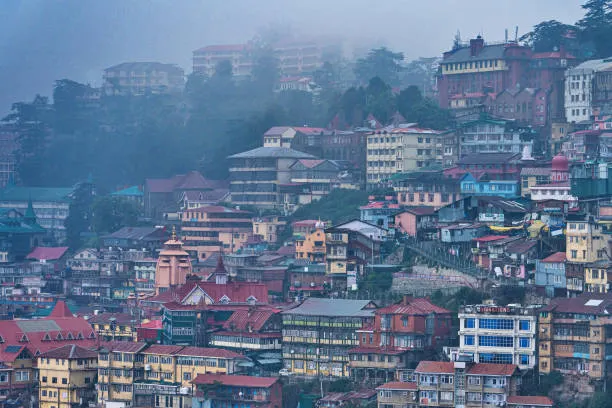Okay, let’s talk about something complicated, something that’s really shaped a region and continues to cause a lot of tension – the Simla Agreement. I’ve been diving into this topic for a long time now, not just reading about it in textbooks, but trying to understand the real-life consequences for the people involved. I actually spent a few years working with a small NGO that focused on conflict resolution in South Asia, and while we weren’t *directly* involved in the Simla process, we constantly dealt with the fallout – the mistrust, the displacement, the persistent problems stemming from unresolved issues. That work gave me a really unique perspective, a feeling of being on the ground, talking to people whose lives are still affected decades later. It’s not a pretty story, and the Simla Agreement is a huge piece of that puzzle. So, grab a cup of coffee (or chai, if you’re feeling it!), and let’s unpack this.
The very name “Simla” – a hill station in northern India – just feels heavy with history, doesn’t it? It’s where, in 1972, the leaders of India and Pakistan sat down to try and figure out what to do about Kashmir. Now, Kashmir is *the* knot in the region, the issue that’s fueled wars, political instability, and a deep-seated sense of grievance for generations. Before 1972, India and Pakistan had fought a brutal war over the territory, and the outcome was…well, messy. The Line of Control (LoC) – officially, a ceasefire line – was established, but it wasn’t a neat, easily understood border. It was, and still is, a heavily disputed zone, marked by a lot of military presence and a whole heap of uncertainty for the people living on either side.
The immediate context was huge. The 1971 war in East Pakistan (now Bangladesh) had just ended, and Pakistan was reeling. Nixon and Indira Gandhi were navigating a tense relationship with the Soviet Union, and there was a real urgency to de-escalate the situation in Kashmir. Zulfiqar Ali Bhutto, Pakistan’s Prime Minister at the time, and Indira Gandhi, India’s leader, recognized that a formal, legally binding agreement was needed to prevent future conflict, even if it wasn’t a perfect solution. That’s where Simla came in.
What ‘Was’ the Simla Agreement, Exactly? Let’s Break It Down
The Simla Agreement, officially titled “Shakambara Agreement” (meaning “the bed of the beggar” in Sanskrit – a bit of a strange name, right?), was the result of intense negotiations. It wasn’t crafted in a vacuum; it was built on a foundation of existing agreements and understandings, although a lot of those were shaky at best. The core aim was simple: to establish a framework for peaceful resolution of the Kashmir dispute. It wasn’t about deciding who *owns* Kashmir – that’s still a point of contention – but about how to manage the territory and prevent future war.
Let’s look at the key provisions, and honestly, they’re not exactly revolutionary in their ambition…which is, in a way, what made them so frustratingly difficult to implement.
Mutual Recognition of Sovereignty: This is probably the most important, and the most problematic, piece. India and Pakistan agreed to recognize each other’s sovereignty and territorial integrity. Sounds good, right? But in practice, it just codified the existing situation – India controlled the majority of Kashmir, Pakistan controlled a smaller portion (administered as Azad Kashmir and Gilgit-Baltistan), and both sides claimed the whole territory. Neither side was willing to cede ground.
Demilitarization: The agreement called for demilitarization of the area along the Line of Control. This meant reducing the number of troops and weaponry deployed on both sides. This was a major step, and it was *supposed* to create a more stable environment. However, both India and Pakistan have consistently violated this provision, adding to the friction and mistrust. “Demilitarization” is a lovely word, but the reality of a heavily militarized LoC is a stark contrast.
Cessation of Active Operations: This was designed to put an end to ongoing fighting. Again, it was a step in the right direction, but it didn’t eliminate the underlying tensions or the potential for renewed conflict. It’s like putting a bandage on a serious wound – it provides temporary relief, but it doesn’t address the root cause.
Holding of Talks: Perhaps the most hopeful provision, and also the one that’s been repeated most often over the decades. The agreement stipulated that India and Pakistan would engage in “sustained and progressively greater cooperation” through dialogue to find a peaceful solution to the Kashmir problem. This was the cornerstone of the whole agreement, the idea that communication and negotiation could ultimately lead to a resolution. Unfortunately, these talks have stalled repeatedly.
Return of Prisoners of War (POWs): A humanitarian aspect, returning captured soldiers and civilians to their families. It was a relatively successful element of the agreement, and the exchange of POWs has happened several times since 1972, although the process has been punctuated by disagreements and delays.
Establishment of a ‘Special Kashmir Commission’: This was a somewhat vague provision intended to explore options for resolving the Kashmir dispute. The commission never really got off the ground. It just sat there, a symbol of unfulfilled potential.
The Context Behind the Agreement: A Tangled Web of History and Politics
Understanding the Simla Agreement requires understanding the historical context. Kashmir’s story is incredibly complex, rooted in British colonial policies and the region’s diverse ethnic and religious makeup. The Maharaja of Kashmir, Hari Singh, initially resisted Indian independence and sought to remain a separate kingdom. However, facing invasion by Pakistani-backed tribal militias, he acceded to India in 1947. This act triggered another war between India and Pakistan and laid the foundation for the long-standing dispute.
The 1947 Instrument of Accession, the agreement by the Maharaja, is still fiercely debated in both countries. Pakistan claims it was obtained under duress, while India maintains it was a legitimate decision by the Maharaja. This disagreement over the legitimacy of the accession is a constant source of tension and denial of justice for many Kashmiris.
Bhutto and Indira Gandhi were operating in a particularly challenging political climate. The Soviet Union was flexing its muscles, and the Cold War was in full swing. Both leaders needed a face-saving way to de-escalate the situation, and Simla offered that possibility. However, both leaders also had strong domestic constituencies – nationalist hardliners who were vehemently opposed to any concessions on Kashmir.
The Immediate Impact – A Fleeting Moment of Hope
In the short term, the Simla Agreement did bring a period of relative calm. The demilitarization process, though imperfect, did reduce the intensity of fighting along the Line of Control. There were even some positive developments in terms of cross-border trade and human contact. For some people living along the LoC, it was a welcome respite from the constant threat of violence.
However, this peace was fragile. Both India and Pakistan continued to build up their military forces along the LoC, and skirmishes and violations of the demilitarization agreement became commonplace. The ‘sustained and progressively greater cooperation’ envisioned in the agreement never materialized. Talks were initiated, then stalled, then restarted, only to be abandoned again and again.
Why Did It Fail (and Why Does It Keep Trying to Be Restarted)?
The Simla Agreement’s failure isn’t a surprise to anyone who’s followed the Kashmir issue closely. There are a multitude of reasons why it fell apart and why attempts to revive it have repeatedly failed. Here are some of the key factors:
Fundamental Disagreement on Kashmir’s Status: This is the biggest obstacle. India insists on the principle of “integral sovereignty” over Kashmir, meaning they won’t consider the possibility of a plebiscite (a vote for the people of Kashmir) to determine their future. Pakistan, on the other hand, maintains that the Kashmiri people should have the right to self-determination. These diametrically opposed positions make compromise virtually impossible.
Lack of Political Will: Both governments have consistently lacked the political will to genuinely pursue a solution. Nationalist sentiment in both countries often prioritizes military strength and asserting claims over finding a peaceful resolution. Powerful lobbies and political factions actively oppose any concessions.
The Role of Extremist Groups: Separatist and militant groups operating in Kashmir have actively undermined peace efforts, often resorting to violence and terrorism to disrupt the dialogue process. They benefit from the instability and mistrust and exploit the situation for their own agendas.
The “Azad Kashmir” Factor: Pakistan’s administration of Azad Kashmir is often portrayed in India as a puppet state, and vice versa. The fundamental question of who controls and governs the territory, and how, is a significant stumbling block.
Trust Deficit: Decades of conflict and broken promises have created a deep-seated lack of trust between the two sides. It’s incredibly difficult to build a sustainable peace agreement when there’s no foundation of mutual trust.
External Interference: Other countries, particularly the United States and China, have attempted to play a mediating role, but their efforts have often been unsuccessful due to the complex dynamics of the situation.
The Simla Agreement in Current Affairs – A Lingering Shadow
Even today, the Simla Agreement remains a point of reference – and disappointment – for both India and Pakistan. It’s regularly invoked during high-level talks, often as a starting point for renewed dialogue. However, each attempt to revive the process ends in frustration and renewed stalemate.
The current situation along the Line of Control is tense. There have been a significant increase in ceasefire violations in recent years, and the risk of renewed violence is ever-present. The ongoing unrest in Kashmir, fueled by frustration over human rights abuses and a lack of political representation, further complicates the situation.
In recent years, there’s been a shift in rhetoric, with both leaders expressing a greater willingness to engage in dialogue. However, the underlying issues remain unresolved. There’s a growing recognition that the “status quo” is not sustainable and that a long-term solution is needed. But finding that solution – a solution that truly addresses the aspirations of the Kashmiri people – remains a monumental challenge.
Looking Ahead – Is There Any Hope?
Honestly, it’s difficult to say. The challenges are immense, and the history of the Kashmir dispute is one of repeated failures. However, there are some glimmers of hope. There’s a greater awareness, particularly among younger generations in both countries, that violence is not the answer and that a peaceful resolution is essential for the future.
A truly effective approach needs to be bottom-up, involving the Kashmiri people themselves. Any solution must respect their right to self-determination and address their legitimate grievances. It’s not about imposing a solution from Delhi or Islamabad; it’s about creating a framework that allows the people of Kashmir to decide their own future.
Ultimately, the Simla Agreement represents both a missed opportunity and a reminder of the enduring complexity of the Kashmir issue. It highlights the need for sustained dialogue, trust-building, and a genuine commitment to finding a peaceful and just solution – a solution that prioritizes the well-being and dignity of all those affected. And that, I believe, is something worth striving for, even if the path ahead is long and arduous.
Do you want me to delve deeper into any specific aspect of the Simla Agreement, such as:
* The role of the Kashmiri people in the conflict?
* The impact of the agreement on the lives of civilians living near the Line of Control?
* A specific historical event related to the Simla Agreement?
Sourashis Chanda brings readers their unique perspective on Business, Economy, Health and Fitness. With a background in Health and Physical Fitness of 2years, I am dedicated to exploring [what they aim to achieve with their writing, on the sustainable Economy of the country, various pro tips about business, latest goverment news, with some tips in health are and Fitness.





